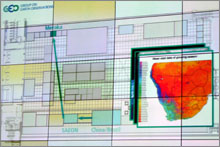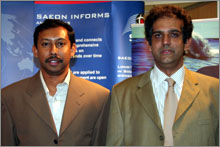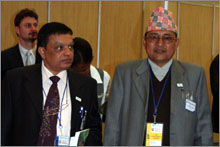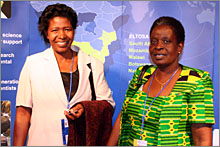GEO Ministerial Summit puts Earth observation science on international radar screen
|
On 30 November last year, five years after the World Summit on
Sustainable Development, more than 600 ministers and officials from
over 100 governments and international organisations involved in
environmental monitoring assembled in Cape Town for the GEO Summit.
The Summit allowed participating nations to:
- Report to Ministers on the early progress made in the implementation of the Global Earth Observation System of Systems (GEOSS) and against the GEO 10-Year Implementation Plan;
- Bring emerging priorities to the attention of the Ministers;
- Engage the commitment of Ministers to endorse the Declaration of Cape Town
The Declaration recognises "that sound policymaking for addressing the environment and sustainable development must be based on understanding, describing, and predicting a complex and interdependent world, and therefore requires terrestrial, oceanic, air-borne, and space-based Earth observations, data assimilation techniques and Earth system modeling".
It also recognises the contribution that a Global Earth Observation System of Systems, or GEOSS, can make in collaboration with the UN Conventions on climate change, biological diversity and desertification, and it highlights a range of other critical issues and principles.
Reaping the rewards
"All countries will benefit from the Global Earth Observation System of Systems," Prof Jose Achache, Director of the GEO Secretariat said at the Summit. "But perhaps the greatest rewards will be reaped by developing countries that are particularly vulnerable to natural disasters, disease outbreaks and other barriers to sustainable development."
The Department of Science and Technology (DST) developed the South African Earth Observation Strategy (SAEOS) and established the South African Environmental Observation Network (SAEON) as part of its engagement with the international community in promoting an integrated global earth observation system.
SAEON played a prominent part in the proceedings by launching its Egagasini Node for marine-offshore systems as a side event of the Summit, and featuring in the definitive GEO publications The Full Picture (a glossy coffee table publication on Earth observation science) and 100 Steps to GEOSS (which focuses on advances made in environmental observation towards a global environmental observation system of systems).
Multi-national exhibition
Ministers, delegates and the general public also had the opportunity to visit the accompanying multi-national exhibition on Earth observations that featured some 60 exhibits on all aspects of Earth observing systems, information products and decision-support tools.
The SAEON stand was visited by a wide range of stakeholders including national and international researchers, observation scientists, media, learners, students, SAEON partners, government decision-makers and ministers who attended the Summit.
The Ministerial Summit of the intergovernmental Group on Earth Observations (GEO) was hosted by the Department of Science and Technology (DST), a co-chair of GEO.
For more information on GEO, please click here and visit: www.earthobservations.org









